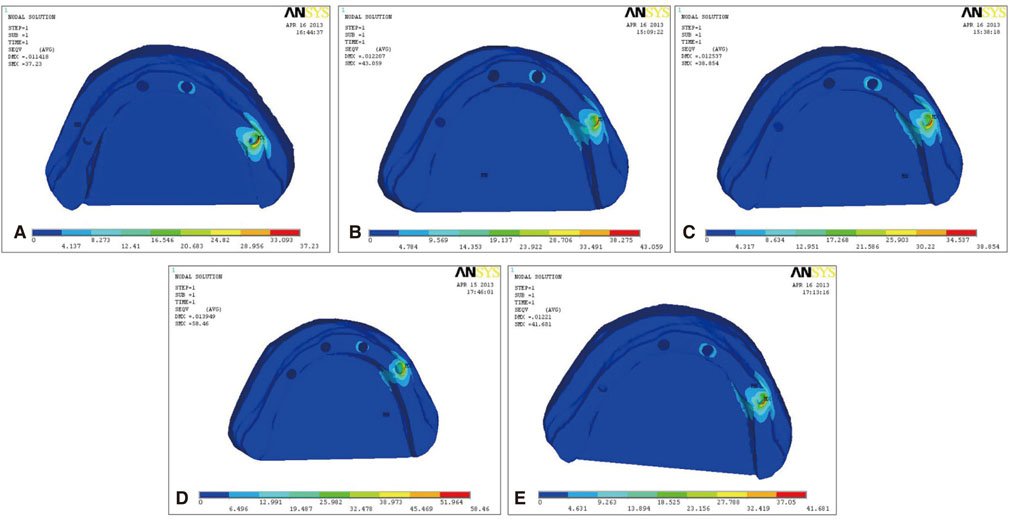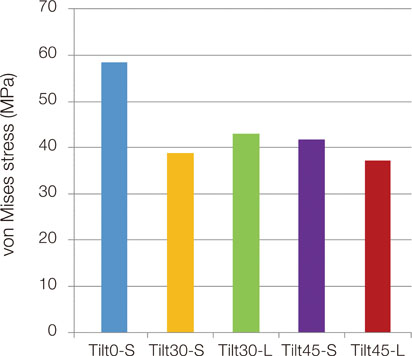J Adv Prosthodont.
2015 Jun;7(3):240-248. 10.4047/jap.2015.7.3.240.
Does matching relation exist between the length and the tilting angle of terminal implants in the all-on-four protocol? stress distributions by 3D finite element analysis
- Affiliations
-
- 1Department of Stomatology, Changhai Hospital, Shanghai, China. wang_dento@163.com
- 2School of Life Sciences and Technology, Tongji University, Shanghai, China.
- KMID: 2284710
- DOI: http://doi.org/10.4047/jap.2015.7.3.240
Abstract
- PURPOSE
To explore whether there is matching relation between the length and the tilting angle of terminal implants in the All-on-Four protocol by studying the effects of different implant configurations on stress distributions of implant, bone, and framework.
MATERIALS AND METHODS
Four implants were employed to support a full-arch fixed prosthesis and five three-dimensional finite element models were established with CT images, based on the length (S and L) and distal tilt angle (0degrees, 30degrees and 45degrees) of terminal implants for an edentulous mandible, which named: Tilt0-S, Tilt30-S, Tilt30-L, Tilt45-S and Tilt45-L. An oblique 240 N was loaded at second molar. The von Mises Stresses were analyzed. The implants were consecutively named #1 to #4 from the loading point.
RESULTS
1) Tilt0-S had the greatest stress on the implants, with the other groups exhibiting variable reductions; the four implants of Tilt45-L demonstrated the greatest reduction in stress. 2) Tilt0-S had the greatest stress at bone around #1 implant neck, and Tilt45-L exhibited the least stress, which was a 36.3% reduction compared to Tilt0-S. 3) The greatest stress in the framework was found on the cantilevers distal to #1 implant. Tilt45-S exhibited the least stress.
CONCLUSION
Matching different length and tilting angle of the terminal implants led to variable stress reductions on implants, bone and the superstructure. By optimizing implant configuration, the reduction of stress on implants and surrounding bone could be maximized. Under the present condition, Tilt45-L was the preferred configuration. Further clinical testings are required.
Keyword
Figure
Reference
-
1. Strassburger C, Kerschbaum T, Heydecke G. Influence of implant and conventional prostheses on satisfaction and quality of life: A literature review. Part 2: Qualitative analysis and evaluation of the studies. Int J Prosthodont. 2006; 19:339–348.2. Adell R, Lekholm U, Rockler B, Branemark PI. A 15-year study of osseointegrated implants in the treatment of the edentulous jaw. Int J Oral Surg. 1981; 10:387–416.3. Branemark PI, Svensson B, van Steenberghe D. Ten-year survival rates of fixed prostheses on four or six implants ad modum Branemark in full edentulism. Clin Oral Implants Res. 1995; 6:227–231.4. Francetti L, Agliardi E, Testori T, Romeo D, Taschieri S, Del Fabbro M. Immediate rehabilitation of the mandible with fixed full prosthesis supported by axial and tilted implants: interim results of a single cohort prospective study. Clin Implant Dent Relat Res. 2008; 10:255–263.5. Capelli M, Zuffetti F, Del Fabbro M, Testori T. Immediate rehabilitation of the completely edentulous jaw with fixed prostheses supported by either upright or tilted implants: a multicenter clinical study. Int J Oral Maxillofac Implants. 2007; 22:639–644.6. Malo P, Rangert B, Nobre M. "All-on-Four" immediate-function concept with Branemark System implants for completely edentulous mandibles: a retrospective clinical study. Clin Implant Dent Relat Res. 2003; 5:2–9.7. Shackleton JL, Carr L, Slabbert JC, Becker PJ. Survival of fixed implant-supported prostheses related to cantilever lengths. J Prosthet Dent. 1994; 71:23–26.8. Correa S, Ivancik J, Isaza JF, Naranjo M. Evaluation of the structural behavior of three and four implant-supported fixed prosthetic restorations by finite element analysis. J Prosthodont Res. 2012; 56:110–119.9. Bellini CM, Romeo D, Galbusera F, Taschieri S, Raimondi MT, Zampelis A, Francetti L. Comparison of tilted versus nontilted implant-supported prosthetic designs for the restoration of the edentuous mandible: a biomechanical study. Int J Oral Maxillofac Implants. 2009; 24:511–517.10. Skalak R. Biomechanical consideration in osseointegrated prostheses. J Prosthet Dent. 1983; 49:843–848.11. Fazi G, Tellini S, Vangi D, Branchi R. Three-dimensional finite element analysis of different implant configurations for a mandibular fixed prosthesis. Int J Oral Maxillofac Implants. 2011; 26:752–759.12. Naini RB, Nokar S, Borghei H, Alikhasi M. Tilted or parallel implant placement in the completely edentulous mandible? A three-dimensional finite element analysis. Int J Oral Maxillofac Implants. 2011; 26:776–781.13. Takayama H. Biomechanical considerations on osseointegrated implants. In : Hobo S, Ichida E, Garcia LT, editors. Osseointegration and Occlusal Rehabilitation. 2nd ed. Tokyo: Quintessence;1990. p. 265–280.14. Stegaroiu R, Sato T, Kusakari H, Miyakawa O. Influence of restoration type on stress distribution in bone around implants: a three-dimensional finite element analysis. Int J Oral Maxillofac Implants. 1998; 13:82–90.15. Sertgöz A, Güvener S. Finite element analysis of the effect of cantilever and implant length on stress distribution in an implant-supported fixed prosthesis. J Prosthet Dent. 1996; 76:165–169.16. Rodriguez AM, Aquilino SA, Lund PS. Cantilever and implant biomechanics: a review of the literature, Part 2. J Prosthodont. 1994; 3:114–118.17. Kim KS, Kim YL, Bae JM, Cho HW. Biomechanical comparison of axial and tilted implants for mandibular full-arch fixed prostheses. Int J Oral Maxillofac Implants. 2011; 26:976–984.18. Gita Malathi K, Ravi Chandra PV. Mechanical complications with implants and implant prostheses. Indian J Dent Adv. 2011; 3:555–558.19. Montero J, Manzano G, Beltrán D, Lynch CD, Suárez-García MJ, Castillo-Oyagüe R. Clinical evaluation of the incidence of prosthetic complications in implant crowns constructed with UCLA castable abutments. A cohort follow-up study. J Dent. 2012; 40:1081–1089.20. Brägger U, Aeschlimann S, Bürgin W, Hämmerle CH, Lang NP. Biological and technical complications and failures with fixed partial dentures (FPD) on implants and teeth after four to five years of function. Clin Oral Implants Res. 2001; 12:26–34.21. Naert I, Quirynen M, van Steenberghe D, Darius P. A study of 589 consecutive implants supporting complete fixed prostheses. Part II: Prosthetic aspects. J Prosthet Dent. 1992; 68:949–956.22. Pjetursson BE, Tan K, Lang NP, Brägger U, Egger M, Zwahlen M. A systematic review of the survival and complication rates of fixed partial dentures (FPDs) after an observation period of at least 5 years. Clin Oral Implants Res. 2004; 15:625–642.23. Kreissl ME, Gerds T, Muche R, Heydecke G, Strub JR. Technical complications of implant-supported fixed partial dentures in partially edentulous cases after an average observation period of 5 years. Clin Oral Implants Res. 2007; 18:720–726.24. Zampelis A, Rangert B, Heijl L. Tilting of splinted implants for improved prosthodontic support: a two-dimensional finite element analysis. J Prosthet Dent. 2007; 97:S35–S43.25. Sertgöz A. Finite element analysis study of the effect of superstructure material on stress distribution in an implant-supported fixed prosthesis. Int J Prosthodont. 1997; 10:19–27.26. Rubo JH, Capello Souza EA. Finite-element analysis of stress on dental implant prosthesis. Clin Implant Dent Relat Res. 2010; 12:105–113.27. Bevilacqua M, Tealdo T, Pera F, Menini M, Mossolov A, Drago C, Pera P. Three-dimensional finite element analysis of load transmission using different implant inclinations and cantilever lengths. Int J Prosthodont. 2008; 21:539–542.28. Korioth TW, Johann AR. Influence of mandibular superstructure shape on implant stresses during simulated posterior biting. J Prosthet Dent. 1999; 82:67–72.
- Full Text Links
- Actions
-
Cited
- CITED
-
- Close
- Share
- Similar articles
-
- Three-dimensional finite element analysis for stress distribution on the diameter of orthodontic mini-implants and insertion angle to the bone surface
- Effects of implant tilting and the loading direction on the displacement and micromotion of immediately loaded implants: an in vitro experiment and finite element analysis
- A three-dimensional finite-element analysis of influence of splinting in mandibular posterior implants
- Three-dimensional finite element analysis of implant-supported crown in fibula bone model
- A study on the stress analysis of three root-form implants with finite element analysis








